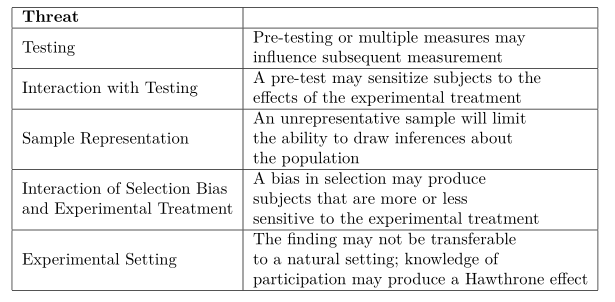2.4: Threats to Validity
- Page ID
- 7211
To understand the pros and cons of various designs and to be able to better judge specific designs, we identify specific threats to internal and external validity. Before we do so, it is important to note that a (perhaps the) primary challenge to establishing internal validity in the social sciences is the fact that most of the phenomena we care about have multiple causes and are often a result of some complex set of interactions. For example, X may be only a partial cause of Y or X may cause Y, but only when Z is present. Multiple causation and interactive effects make it very difficult to demonstrate causality, both internally and externally. Turning now to more specific threats, Table 2.1 identifies common threats to internal validity and Table 2.2 identifies common threats to external validity.
| Threat | |
|---|---|
| History | Any event that occurs while the experiment is in progress might be an alternation; using a control group mitigates this concern. |
| Maturation | Normal changes over time (e.g., fatigue or aging) might affect the dependent variable; using a control group mitigates this concern |
| Selection Bias | If randomization is not used to assign participants, the groups may not be equivalent |
| Experimental Mortality | If groups lost participants (e.g., due to dropping out of the experiment) they may not be equivalent. |
| Testing | A pre-test may confound the influence of the experimental treatment; using a control group mitigates this concern |
| Instrumentation | Changes or difference in the process of measurements might alternatively account for differences |
| Statistical Regression | The natural tendency for extreme scores to regress or move towards the mean |
Figure \(\PageIndex{2}\): Common Threats to External Validity



